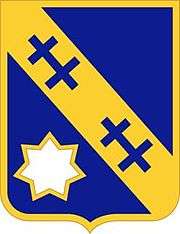140th Infantry Regiment (United States)
| 140th Infantry Regiment | |
|---|---|
 Coat of arms | |
| Country | United States |
| Allegiance | Missouri |
| Branch | Missouri Army National Guard |
| Type | Infantry |
| Motto(s) | Siempre Listo (Always Ready) |
| Engagements |
American Civil War Spanish-American War World War I World War II |
| Insignia | |
| Distinctive unit insignia |
 |
| U.S. Infantry Regiments | |
|---|---|
| Previous | Next |
| 139th Infantry Regiment | 141st Infantry Regiment |
The 140th Infantry Regiment was an infantry regiment of the United States Army, Missouri Army National Guard. It is one of the few US Army regiments that trace its heritage to historic regiments of the Confederate States Army, the 6th Missouri Infantry. They continued to serve through the Spanish-American War, World War I, and World War II before its deactivation in 1963.[1]
History
The 6th Missouri was first organized in 1862 during the American Civil War in order to serve the Confederate States of America. The former Missouri State Guard battalions under CPT J.W. Hedgpeth and CPT Eugene Erwin joined together at Guntown, Mississippi in September 1862 to consolidate into the 6th Missouri. CPT Erwin was promoted to Colonel, and became the regimental commander. They fought as a part of the Confederate Missouri Brigade in the Battle of Iuka, the Second Battle of Corinth, the Battle of Grand Gulf, and the Battle of Port Gibson. During the Battle of Corinth, the 6th Missouri suffered 214 total casualties. Then at Port Gibson, the Missourians distinguished themselves by advancing ahead of the main battle line in order to recapture lost artillery pieces.[2] During the Siege of Vicksburg on 25 June 1863, COL Erwin was killed in action while attacking the Union Army's 45th Illinois Volunteer Infantry Regiment. When the Confederates eventually surrendered at Vicksburg on 4 July 1863, the 6th Missouri suffered more casualties than any other Confederate unit in the campaign.[2] In September 1863, the 6th Missouri consolidated with the 2nd Missouri due to its heavy losses at Vicksburg, and had earned the moniker, "The Bloody Sixth." The new 2/6th Missouri fought valiantly in the Battle of New Hope Church, Battle of Kennesaw Mountain, Battle of Franklin, Battle of Allatoona, and the Battle of Fort Blakely in the closing days of the war. The 2/6th Missouri fought fiercely until the last moment, but eventually were forced to surrender in the end.[2]
Following the Civil War, the 6th was reactivated on 27 June 1898 to serve the US Army during the Spanish-American War where it served in the occupation force in Cuba. It was again disbanded on 25 July 1914.[3]
On 29 June 1917, the regiment was reactivated for service in the First World War when it consolidated with elements of the 3rd Missouri to create the 140th Infantry Regiment in October 1917. The new regiment was assigned to the 35th Infantry Division. Within the 35th Division they were assigned to the 70th Brigade alongside the 139th Infantry Regiment. Companies of the regiment were drawn primarily from the southeast of the state; A Company hailed from Lexington, B and C Companies were recruited from St. Joseph, D Company came from Sedalia.[3] E, F, G, and H Companies were recruited from Doniphan, Willow Springs, Richmond, and Dexter respectively.[3] I, K, L, and M Companies were pulled from Kennett, Sikeston, Cape Girardeau and Poplar Bluff respectively.[3] Additional troops were recruited from Jefferson City, Seymour, Carterville, and West Plains.[3] The regiment organized and trained in the United States at Camp Doniphan, Oklahoma and then shipped out for France where it began training under British tutelage in June 1918.[3] In July, the 140th had its first taste of combat in the Gérardmer sector in the Vosges Mountains, where they conducted raids on German forces. They were moved to the St. Mihiel sector in September where they served as a reserve for the First Army.[3] The regiment soon participated in the Meuse-Argonne Offensive, the largest battle the American Expeditionary Forces waged during the war. After five days of intense battle, they were relieved by elements of the 1st Infantry Division and were placed in the Sommedieue sector where they launched harassing attacks on the enemy positions until the Armistice of 11 November 1918 ended the war.[3] They were deactivated in 1919 with the rest of the 35th Division.
When World War II broke out and America became involved due to the Attack on Pearl Harbor in 1941, the 140th Infantry Regiment was detached from service in the 35th Infantry Division in order to defend against possible Japanese attacks on the West Coast, where they remained until the end of the war.
The 140th finally cased its colors in 1963 when it was formally deactivated as a maneuver infantry regiment.[1] It serves today as the 140th Regiment, and runs the RTI (Regional Training Institute) for the Missouri Army National Guard.
References
- 1 2 "Former 140th Infantry Regiment plans biannual reunion". 5 March 2007.
- 1 2 3 "Brief History of the 6th Missouri Infantry CSA The 6th MO Infantry began organization in the summer of 1862 and was completed at".
- 1 2 3 4 5 6 7 8 "Full text of "From Doniphan to Verdun : the official history of the 140th infantry"".